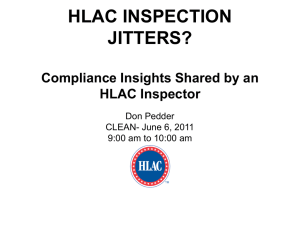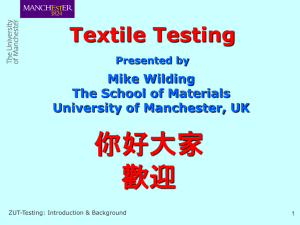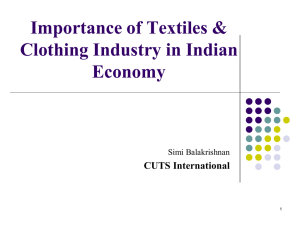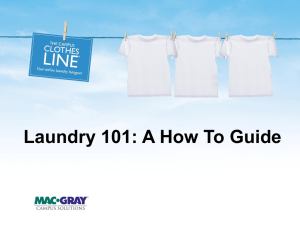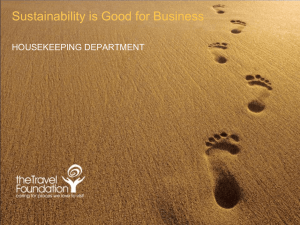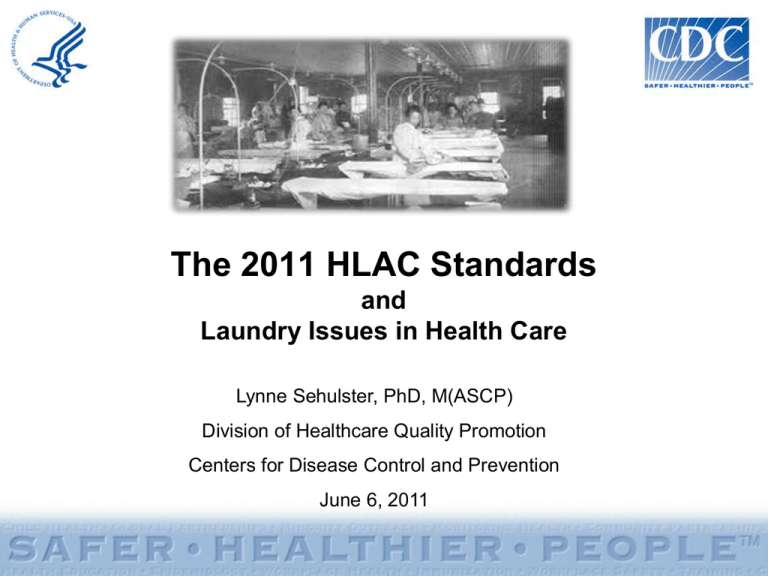
The 2011 HLAC Standards
and
Laundry Issues in Health Care
Lynne Sehulster, PhD, M(ASCP)
Division of Healthcare Quality Promotion
Centers for Disease Control and Prevention
June 6, 2011
Disclaimer / Disclosures
The findings and conclusions in this presentation are
those of the author and her information resources
and do not necessarily represent any determination
or policy of the Centers for Disease Control and
Prevention (CDC).
The author is an employee of the Federal government
(DHHS) and has no commercial affiliations or
conflicts of interest to disclose.
Any products mentioned or discussed in this lecture
are for identification purposes only and does not
constitute an endorsement by the Federal
government.
Today’s Topics
• Introduction to CDC
• 2011 HLAC Standards
– What’s new and improved
– General topics addressed
• Upcoming issues in healthcare laundry
– Implications of the 2009 Rhizopus outbreak
– Do we stay with Hygienically Clean as the
standard?
– Evidence-based information guides practice
Introduction to the Centers for
Disease Control and
Prevention (CDC)
Centers for Disease Control and
Prevention (CDC)
• Federal government agency with the Dept. of Health and
Human Services (DHHS)
– Only Federal government agency based outside of Washington,
DC
• CDC is not a regulatory agency
– Public health epidemiology, public health applications, outbreak
investigations, guidelines
• 6 public health program Offices
– Office of Infectious Diseases
• 8 National Centers, 1 National Institute (NIOSH)
– National Center for Emerging and Zoonotic Infectious Diseases
Division of Healthcare Quality
Promotion
• DHQP’s mission: Protect patients, protect health-care
personnel, and promote safety, quality, and value in the
health-care delivery system
• “Winnable battle:” Healthcare-associated infections
• Collaborate with Federal government partners
– FDA, EPA, CMS, USDA, AHQR
• Major products:
– Healthcare guidelines produced under auspices of the
Healthcare Infection Control Advisory Committee (HICPAC)
– National Healthcare Safety Network (NHSN)
– Research: outbreak investigations, surveillance trend analyses,
laboratory support, Epi Center program for applied research
CDC / HICPAC Guidelines:
Laundry and Bedding
From the “Guidelines for Environmental
Infection Control in Health-Care Facilities”
(2003):
Epidemiology and General Aspects of
Infection Control
Collecting, Transporting, and Sorting
Contaminated Textiles and Fabrics
Parameters of the Laundry Process
Special Laundry Situations
Surgical Gowns, Drapes, and Disposable
Fabrics
Antimicrobial-Impregnated Articles and
Consumer Items Bearing
Antimicrobial Labeling
Standard Mattresses, Pillows, and AirFluidized Beds
Laundry and Infectious Diseases
● Textiles contaminated with body substances
can contain large numbers of
microorganisms (106 – 108 cfu/100 cm2 fabric)
● Few reports in the literature link laundry to
disease transmission when proper
procedures are followed
● Annual estimates for volume of laundry
processed in U.S. health care: 5 billion lbs.
(1980s, early 1990s estimate; now?)
● Continue current infection prevention
practices
Current Healthcare Laundry
Standard in the U.S.
● Standard: Hygienically clean
● Not quantified for microorganisms, but assume
textiles are generally rendered free of vegetative
pathogens
● Through a combination of soil removal, pathogen
removal, pathogen inactivation, contaminated
textiles are rendered hygienically clean
● Carries negligible risk to healthcare workers and
patients, providing that the clean textiles are not
inadvertently contaminated before use
Main Steps of Healthcare
Laundry Processing
• Collection of soiled textiles at point of use
• Transport to laundry
• Wash cycle:
– Flush, main wash, bleaching, rinsing, souring
• Dried and pressed
• Packaged, loaded into carts
• Delivery back to the hospital
Laundry Operations
● If using hot water washing, water temperature
>71° C (>160° F) is needed
● Some healthcare facilities may not have access to
water at this temperature
● Chlorine bleach (50 – 150 ppm) is effective
laundry additive, especially in hot water
● One of the rinses includes a mild acid (sour) to
neutralize residual alkalinity from the wash
● Helps to inactivate microorganisms
● Reduces risk of skin reaction to alkali
Alternatives to Hot-water
Laundry
● In-house laundries consume an average of 50%
- 70% of the facility’s hot water (10% - 15% of
the total energy used)
● Water temperature may be regulated
● Lower temperature wash cycles can be used
with appropriate detergents and laundry
additives
● New detergents and processes (e.g., oxidative
products) need study
Laundry Transport /
Storage
• Separate clean textiles from contaminated textiles
when transporting in a vehicle
• Physical barriers and/or space separation
• Clean, unwrapped textiles can be stored in a clean
location for short periods of time
• Unwrapped textiles should be stored so to prevent
inadvertent contamination by soil or body
substances
• This is the part of the overall process that is
most vulnerable to outside contamination
The Healthcare Laundry
Accreditation Council (HLAC)
2011 HLAC Standard
The HLAC Standard for 2011
● Supersedes the
HLAC Standard of 2006
● More detailed, less
ambiguity
● Comprehensive in
scope
● Thoroughly
referenced
● Its message: Patientfocused infection
prevention
● Advances the
industry
The Healthcare Laundry Accreditation Council
Accreditation Standards for Processing Reusable Textiles
for Use in Healthcare Facilities
2011 Edition
Published June 2011
by
The Healthcare Laundry Accreditation Council
P.O. Box 1805, Frankfort, IL 60423
Office: 1-815-464-1404 • Toll-free: 1-855-277-HLAC (4522)
www.hlacnet.org
© 2011. All Rights Reserved.
Healthcare Laundry Accreditation Council
HLAC Accreditation
• HLAC Standard developed from both laundry
operations and infection prevention expertise
• Inspection process assesses compliance with
the Standard
• Accreditation is voluntary
• Renewal every 3 years is necessary to maintain
accreditation
• Healthcare professionals increasingly aware of
this accreditation program
Preamble: This portion of the 2011
Standard is more comprehensive
and informative compared to the
Introduction and Background in the
2006 Standard:
Introduction
Important
Terminology
States the purpose of the Standards: minimum
acceptable healthcare laundry practices
Defines Universal Precautions; identifies key
participants – provider, customer, end user, inspector
Interpretive
Guidance
Defines the scoring level associated with each
statement’s verb – must, shall, should, may
Disclaimer
Focuses on and clarifies the role of the inspector
Standards: This portion of the 2011 Standard is
expanded extensively in an outline format, with a
step-by-step, systematic approach for processing
healthcare textiles in an efficient and safe
environment to produce a hygienically clean textile
product for patient care.
Content Improvements
Format
Each Standard statement has a unique number and addresses a single point, not
multiple items which previously created scoring problems
Content
Comprehensive and detailed; addresses laundry processes, equipment, functional
separation, quality assurance, worker safety, working environmental issues; minor
reorganization of topics in Parts I and II; the new Standards raise the bar for laundry
processes and product for healthcare textile reprocessing
Verbs
Citations
Greater clarification – scorable statements are clearly identified, and “must” statements
are presented in bold-face type
Scorable statements include citations to support the statement where available,
including government regulations, professional association standards, and peerreviewed literature evidence
Message: Compliance with the new 2011 HLAC Standards will result in patient-focused infection prevention,
enhanced infection control and patient safety through the production of a hygienically clean textile product. This
benefits you – the provider, your customer, but most importantly the patients in your customer’s healthcare facility!
Expansion Example
• 2006 Standard:
3. Contingency Planning
3.1 Contingency planning provides for
uninterrupted operations and services in the
event of any occurrence potentially leading to
serious disruption of facility operations. Such
disruption may include, but is not limited to
loss of utilities, medical emergencies, natural
and/or man-made disasters, fire, inclement
weather, work stoppage, or major accidents.
The contingency plan shall include the
following components: plant and transportation
contingency protocol, call chain, and a list of
back-up facilities.
• 2011 Standard:
3. Contingency Planning
3.1. Contingency Planning
3.1.1. Contingency planning shall provide for
uninterrupted operations and services in the
event of any occurrence potentially leading
to serious disruption of the provider’s
operations. Such disruption includes, but is
not limited to, loss of utilities, medical
emergencies, natural and/or man-made
disasters, fire, inclement weather, work
stoppage, or major accidents.
3.1.2. The contingency plan shall include the
following components:
3.1.2.1. Plant and transportation
contingency protocol,
3.1.2.2. Call chain,
3.1.2.3. A list of backup laundry facilities,
and
3.1.2.4. A backup source of textiles, if
needed.
Key Concepts in Quality for
Healthcare Textiles
• Functional separation
– Primarily accomplished via structural design and
ventilation specifications
– Conceptually also can include work practices to keep
clean textiles separate from soiled textiles
• Hygienically clean textiles
– Contact with clean surfaces at minimum
– Disinfected surfaces may be indicated
Part I. Basic Elements
1. Textile Control Procedures
Textile Specifications
Textile Maintenance
Provider Inventory Management
2. Laundry Facilities
Physical Design, Ventilation, Fixtures, Signage
No cardboard allowed in storage areas, staging area
addressed, storage climate statement simplified
Physical Plant and Equipment Maintenance
Work practices when using conventional washer extractors
Management of Foreign Items and Regulated Wastes
Expansion of sharps policy (see also Part II)
Hazardous materials and pharmaceutical waste management
Piped Air, Water, Wastewater, and Chemicals Management
Comply with local regulations, DHS CSAT: hazardous chemicals
Part I. Basic Elements
3. Contingency Planning
Contingency Planning
Plant Contingency Protocol
Contingency Call Chain
Backup Facility Agreements
4. Laundry Equipment
Documentation
Installation and Utilities Connections
Equipment Operation
Preventive Maintenance
Equipment Calibrations
Repairs
Recordkeeping for New, Existing, and/or Used Equipment
Part I. Basic Elements
5. Laundry Personnel
Personnel Qualifications
Personnel General Responsibilities
Defines the roles of supervisors/managers, employees
Health and Hygiene
Employee Safety
OSHA lock out/tag out requirement; expands safety beyond the
OSHA bloodborne pathogen standard to include chemical
safety and mechanical hazard issues
Personal Protective Equipment (PPE) and Attire
No artificial nails
Occupational Safety and Health Elements
Introduces concept of HBV serologic testing as part of postexposure management (a “May” statement)
Hazardous material safety plan/policy
Training and Educational Programs
Hazardous material safety training
Part I. Basic Elements
6. Laundry Customers
Provider Policy
Contact
Visitation
Customer Complaints
7. Quality Assessment
General Rationale
Quality Control
Quality Assurance
Process Monitoring
Accounting
Part II. The Textile Processing Cycle
1. Handling, Collection and Transportation of Soiled
Healthcare Textiles
Universal Precautions
Handling and Collection
Soiled Textile Containment for Laundries Not Using Universal
Precautions (more detailed compared to 2006 material)
Transportation
Carts Used for Soiled Textiles
2. Sorting
Soiled Sorting Area
Universal Precautions
Sorting Soiled Textiles
Foreign Object Policies
Expansion to include devices (instruments), patients’ personal
items in addition to sharps
Part II. The Textile Processing Cycle
3. Washing and Extraction
Equipment
Washing
Extraction
4. Drying (not new, but given its own subpart)
Equipment
Drying
5. Finishing
Ironing Equipment
Folding and Stacking
Packaging (moved into this subpart)
Reprocessing Requirements
Part II. The Textile Processing Cycle
6. Storage
Rationale
Storage Areas
Storage Options
Reprocessing Requirements
7. Delivery of Cleaned Healthcare Textiles
Rationale
Delivery Methods
Cart Function and Cleanliness
Vehicle Considerations
Occupational safety for vehicle drivers
Part III. Surgical Pack
Assembly Room Standards
• Note: Part III does not address sterilization of
the assembled packs
1. Physical Facilities: Surgical Pack Assembly Area/Room
General Rationale
Floors, Walls, Ceilings and Vents
Separation of Work Areas
Ventilation Requirements for Proper Air Flow and Climate Control
Storage Area for Clean Textile Packs
2. Surgical Pack Assembly Room Entry and Admission
Policies
Location of Hand Hygiene Stations
Part III. Surgical Pack
Assembly Room Standards
3. Surgical Textile Assembly Process
Carts Used to Move Clean Surgical Textiles to the Pack Assembly
Room
Inspection of Clean Surgical Textiles Prior to Pack Assembly
Maintenance of Surgical Textiles
4. Preparation and Wrapping of Surgical Textiles
General Rationale
Folding
Surgical Textile Pack Assembly
Wrapping and Packaging
Labeling/Identification of Packs
Part III. Surgical Pack
Assembly Room Standards
5. Storage and Transportation of Surgical Textile Packs
Storage of Surgical Textile Packs
Transportation of Surgical Textile Packs
6. Surgical Textile Pack Assembly Room Personnel
Qualifications
Training and Competency
Health and Personal Hygiene
Attire and Personal Protective Equipment (PPE)
HLAC Standard 2011: Appendices
Appendices in the 2011 HLAC Standards: Inform, reference, and acknowledge the
many contributions to this first, major revision to the HLAC Standards
Appendix A:
Glossary/Terminology
Appendix B: Abbreviations
Appendix C: Ventilation
Parameters for Healthcare
Laundry Areas
Appendix D: CFR Text for
FDA Devices
Appendix E: References
Provides definitions for terms used in the Standard
Spells out and defines the abbreviations
Provides ventilation specifications in hospital
laundry
Provides the device storage and handling text from
FDA in the Code of Federal Regulations
Bibliography of the references used in the
Standard
Appendix F:
Acknowledgements
Outside reviewers and experts providing comment
during the revision process
Appendix G: HLAC Board of
Directors
2009, 2010, and 2011 HLAC Boards participated in
the review and revision process
Will “Hygienically Clean” Remain the
Standard for Healthcare Textile
Reprocessing?
Mucormycosis
Outbreak
and
Hospital Textiles
Mucormycetes
• Mucormycetes are ubiquitous molds
• 23 pathogenic species; Genus Rhizopus
causes half of all infections
• Rhizopus oryzae most common; genetic
variety observed within species
• Mucormycosis:
– Skin is common site of infection
– Invasive mold: fatality rate highly
variable (ranges from 10% - 94%)
Additional Results
• Patient specimens:
– Type: culture (1), tissue block (3)
– All four (+) for Rhizopus oryzae
• Environmental cultures:
– Hospital A: 13/13 cultures (+) for
Rhizopus oryzae
– Laundry facility: No Rhizopus oryzae
– R. oryzae from one patient and from
clean linen/cart had the same genetic
subtype
Conclusions
• Hospital linens were the most likely vehicle to
have brought Rhizopus in contact with the
patients
• Genetic subtyping of fungal isolates supported
this epidemiologic hypothesis
• Contamination of clean linens with Rhizopus
happened repeatedly, but might have been
intermittent
• Hospital linens should be laundered, shipped,
and stored in a manner that minimizes
exposure to environmental contaminants
Things to Consider
• Some have called for purposeful
sanitization of laundry because of the
outbreak
– Laundering process was not implicated
• Some are advocating treating textiles to
leave antimicrobial chemicals as residue
– Do we know how safe this is for patients?
– EPA may consider this as a “treated article”
Chain of Infection (COI)
● Virulent pathogen:
● Bacteria, fungi, viruses, parasites,
prions
● Sufficient number of pathogen:
● Infectious dose
● Mode of transmission:
● Contact, droplet, airborne
● Portal of entry:
● Broken skin, mucous membrane,
respiratory tract, ingestion
● Susceptible host:
● Age, immunity, medical conditions
Other possible links include reservoir,
portal of exit
What is the Evidence to Justify
Purposeful Sanitization?
• Outbreaks of infection associated with
clean healthcare textiles still a rare event
• Europeans have promoted laundry
disinfection
– More active in laundry disinfection research
• Is laundry disinfection a cost-effective
process?
Why is This Significant?
● Hospital environmental and medical equipment
surfaces rapidly become contaminated
● Recent studies demonstrate that:
● Hands and gloves of healthcare workers readily
acquire pathogens after contact with
contaminated surfaces
● Healthcare workers can transfer these pathogens
to subsequently touched patients and inanimate
surfaces
● Patients subsequently can become
colonized/infected
Basic Strategy Elements for Preventing
and Eliminating Contamination
of Environmental Surfaces
Prevent environmental surface contamination
Handwashing / hand hygiene
Use of barrier coverings on clinical touch surfaces
Responsible use of gloves, personal protective equipment (PPE)
Clean–to–dirty work flow whenever practical
• Avoid dirty-to-clean work flow as much as practical
Remove environmental surface contamination
Cleaning
Inactivate environmental surface contamination
Disinfection for inanimate surfaces
Antisepsis for living tissue
HACCP for Laundry
• Hazard Analysis and Critical Control Point
• Similar to the ICRA currently used in
hospital infection prevention program
• Assess all aspects of the laundering
process to identify opportunities for
contamination to occur
• Owner/operators become proactive in
infection prevention
Textile Management and
C. difficile Contamination
● Consider cohorting symptomatic patients/ residents’
clothing to wash separately from clothing of healthy
residents
● During a wash cycle, do not mingle used cleaning cloths
in with clothing from healthy residents
● High numbers of spores may remain on the cloths if
used with a non-sporicidal disinfectant
● Use of sporicidal disinfectant will reduce the viable
spore number
From: Carbone HL, et al. 2010 Decennial Infection Prevention and
Epidemiology Conference, poster #160
Making the Case for Laundry
Standards Revisions
• Demonstrate added value for product quality,
patient safety, healthcare worker safety
• Research new developments using validated
methods to assess antimicrobial properties
• Make the case for change to your healthcare
customers
– Publish in peer-reviewed journals
– Continue reporting new developments in industry
publications, but explore publication venues typically
used by nurses, EVS directors, hospital
epidemiologists
Acknowledgments
Thanks to:
Nancy Bjerke, RN, BSN, MPH, CIC and Linda
Fairbanks for their leadership in the revision
process for the HLAC Standard
The members of the HLAC Standards Committee
and the members of the HLAC Board of Directors
for deliberation and debate
Jonathan Duffy, MD, MPH for sharing the poster
presented at the Decennial Meeting, 2010
Thank You!
Division of Healthcare Quality Promotion
Centers for Disease Control and
Prevention
“Protect patients, protect health-care personnel, and
promote safety, quality, and value in the health-care
delivery system”


